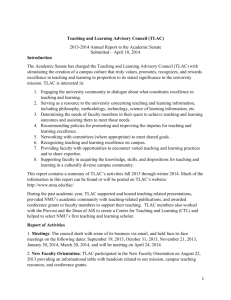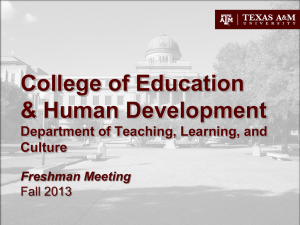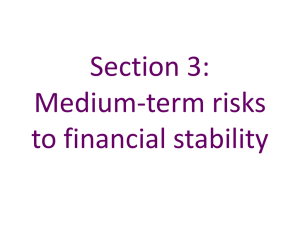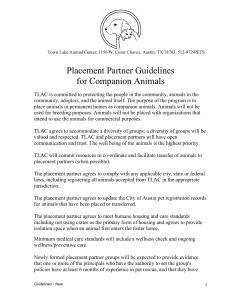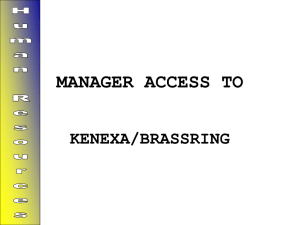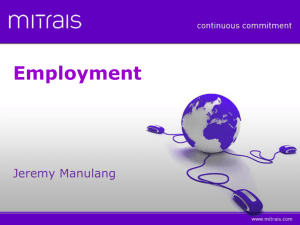tlac second report to the minister - Department of Public Expenditure
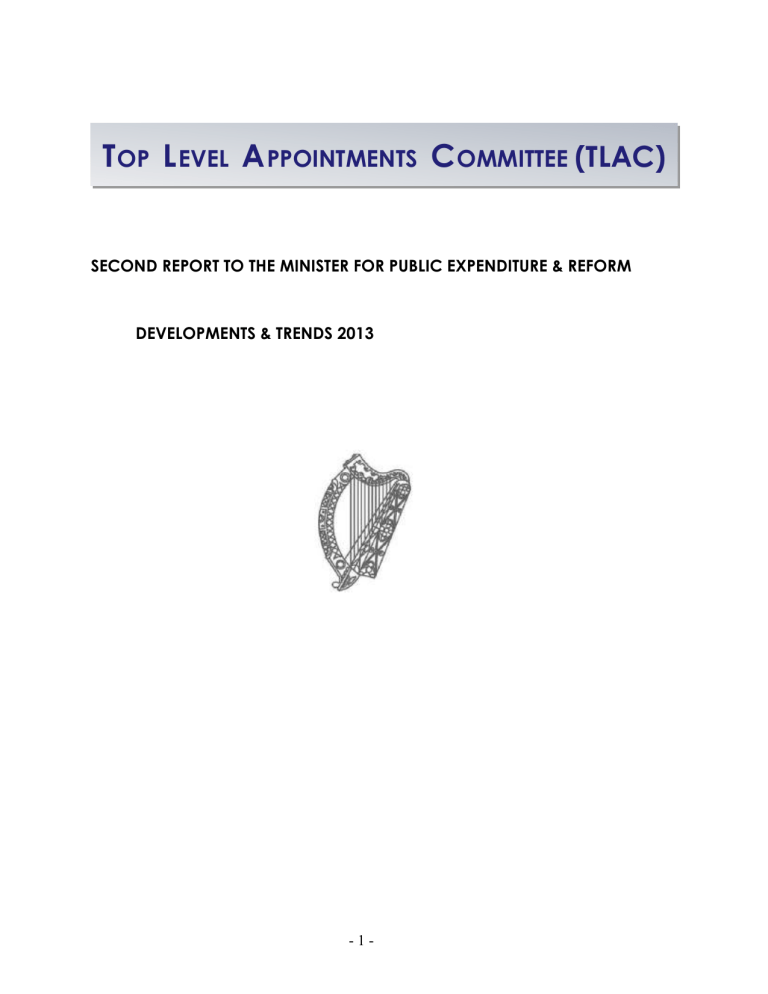
T
OP
L
EVEL
A
PPOINTMENTS
C
OMMITTEE
(TLAC)
SECOND REPORT TO THE MINISTER FOR PUBLIC EXPENDITURE & REFORM
DEVELOPMENTS & TRENDS 2013
- 1 -
T
ABLE OF
C
ONTENTS
Part 1
Foreword . . .
Executive Summary. .
The Role of TLAC. . .
Reformed TLAC Structure .
Part 2
Statistics . .
Trends . .
Considerations .
.
.
.
Appendices
Revised TLAC Role & Procedures
Summary of TLAC Review. .
.
.
.
.
.
.
.
.
.
.
.
.
.
.
.
2
.
.
.
.
.
.
.
.
.
.
.
.
.
.
7
7
3
5
.
.
.
.
.
.
.
.
.
.
.
.
9
16
18
.
20
30
Part 1: Foreword
This report is prepared for the Minster for Public Expenditure &
Reform, Brendan Howlin, T.D.
On behalf of my colleagues, I am happy to present the second report of the reformed Top Level Appointments Committee
(TLAC) for the period December 2012 – December 2013.
In this report we describe developments and trends that are occurring in the TLAC recruitment and selection process. We also raise some considerations for your attention that can support Government policy of open recruitment to attract the best possible candidates to the most senior Civil Service posts.
The Appendices contain the revised TLAC Role and Procedures and some key findings from a TLAC Review carried out by the
Public Appointments Service in December 2013.
The applicant pools presented from within Civil Service
Departments and from the Public Service and Private Sector have, in general, produced strong, competitive candidates for senior management positions. For a number of competitions, however, the quality of the applicant pools has been disappointing. TLAC will continue with the commitment to ensure that potential candidates of calibre from all relevant backgrounds, both within and without the Civil Service, are made aware of the diversity, challenges and rewards of a career at senior level in the Civil Service, and of the open recruitment policy to TLAC posts.
I would like to express TLAC’s appreciation to Ms Maureen
Lynott, TLAC chairperson until November 2013, for her, leadership, energy and dedication in developing the new TLAC.
I would also like to acknowledge the generous commitment of my other TLAC colleagues who have brought their individual skills,
3
foresight and wisdom to the sometimes difficult work involved in
TLAC selection processes.
I would like to sincerely thank the staff of the Public
Appointments Service for their professionalism and ongoing support of TLAC in the execution of its remit together with my appreciation of the dedicated service of Ann Higgins, Secretary to TLAC.
Finally, I would like to thank you, Minister, and your
Department, for your continuing support for the work that TLAC has been mandated to perform.
Dr Dorothy Scally
TLAC Chair
July 2014
4
Executive Summary
In 2010, the Government established a policy of open recruitment from all sectors to the most senior Civil Service positions. Following that, in mid-2011 the structure of the Top
Level Appointments Committee (TLAC) was reformed such that it would have a majority of external members of whom one would be the Chair.
The first TLAC report looked at the 35 competitions for posts at Secretary General and
Assistant Secretary General level, or equivalent, overseen by the newly established
TLAC during the period July 2011 to December 2012.
During 2013, TLAC oversaw the recruitment process for 21 posts, 2 at Secretary General level and the remainder at Assistant Secretary level or equivalent. All of these selection campaigns were successful in identifying and selecting suitable candidates to be recommended for appointment to the positions.
An examination of the data for 2013 identified the following key trends:
A 14% increase in the total number of TLAC applications for 2013, with the average number of applications per post increasing from 28.75 in 2012 to 37.5 in 2013. This increase was due mainly to increased numbers of applications from Civil Servants who represented 41% of all applicants in 2013, compared with 39% in 2012.
The percentage of TLAC appointments to candidates outside the Civil Service in
2013 was 24%, which was similar to the 25% of appointments to non-Civil Servants in 2012, and an increase from 19% in 2011
The background of successful candidates from outside of the Civil Service in 2013 consisted of 10% from the Public Service and 14% from the private sector.
Women are continuing to perform slightly better than men, overall, in TLAC competitions, but there was a decrease in both applications from women (21% of total applications) and women being appointed (24% of appointments) relative to the previous 3 years when 22-26% of applicants and 28%-30% of appointees were women.
Mobility, or movement of Civil Servants to TLAC level posts in other Departments, had been increasing overall from 2010 to 2012 but saw a significant decrease in 2013,
5
with 57% of those appointed to TLAC posts coming from within the same
Department or agency of the Department, relative to 47% in 2012.
During 2013, TLAC continued to focus on ensuring the attraction and selection of the best people for these key appointments through ongoing review and engagement with potential candidate pools and stakeholders:
The then Chair of TLAC, Ms Maureen Lynott, participated in a well attended
Senior Public Service networking event in November 2013, to provide an overview of the new TLAC procedures and to encourage applications.
TLAC, with the support of the Public Appointments Service, availed of retained executive search services in addition to the PAS recruitment campaign, where a particular need was identified for a more targeted attraction of candidates.
During 2013, in order to ensure the efficacy of the selection process, TLAC requested that the Public Appointments Service conduct a survey and engage with Secretaries General who had had new TLAC appointees join their
Departments since July 2011. The Secretaries General were unanimous in their satisfaction with the candidates appointed to these roles. This survey, which also included a survey of a sample of candidates participating in TLAC processes, while generally very positive about the TLAC process, did raise some concerns and suggestions for improvement. A summary of key findings is provided in Appendix 2.
6
The Role of TLAC
The role of TLAC is to support the Government objective that the recruitment and selection process for the most senior Civil Service positions is accessible to the widest pool of qualified candidates from all sectors.
TLAC identifies the best candidate(s) for each position and makes recommendations to the relevant Minister or Government as appropriate.
TLAC operates under the Code of Practice of the Commission for Public Service
Appointments in accordance with the principles of merit, consistency, accountability, probity, best practice and professional confidentiality.
TLAC operates in an independent manner and strictly on the basis of open competition and merit.
Subject to certain exceptions, TLAC deals with all posts at and above Assistant
Secretary level or equivalent in the Civil Service.
Reformed TLAC Structure
In line with the Programme for Government commitment, the restructuring of the Top
Level Appointments Committee (TLAC) was announced in April 2011. The Government decided that the new membership of The Top Level Appointments Committee should comprise, (i) Secretary General, Department of Public Expenditure and Reform; (ii)
Secretary General to the Government; (iii) two other senior public servants appointed for three year terms and; (iv) five members from outside the civil service appointed for three year terms, one of whom would be the chairperson.
In November 2013, the first Chair of the new TLAC, Ms Maureen Lynott, resigned. She was replaced by Dr Dorothy Scally who was a serving external member of TLAC.
Ms Jane Williams was appointed to TLAC to fill the resulting vacancy. The current
TLAC membership is described below:
7
TLAC Committee Members
Dr Dorothy Scally, Professional Development Consultant (Chairperson);
Mr Martin Murphy, Managing Director, Hewlett Packard Ireland;
Mr Clive Brownlee, Praesta Ireland;
Mr Kevin Empey, Director of Corporate Affairs, Towers Watson;
Ms. Jane Williams, CEO, The Sia Group;
Mr Robert Watt, Secretary General, Department of Public Expenditure & Reform;
Mr Martin Fraser, Secretary General to the Government;
Mr Tom Moran, Secretary General, Department of Agriculture, Food & the Marine;
Ms Josephine Feehily, Chairman, Office of the Revenue Commissioners.
The TLAC process, explained more fully in Appendix 1 to this Report, consists of:
An initial recruitment and selection process by the Public Appointments Service in conjunction with TLAC (recruitment campaign, short-listing, preliminary interviews).
Interview of TLAC candidates by a TLAC panel.
Recommendations to Minister/Government.
8
PART 2: Statistics (Jan-2010 to Dec-2013)
Refers to the date of the new TLAC commencing work, i.e. 18 th July 2011
TLAC activity in 2013
TLAC oversaw the recruitment process for twenty-one positions in 2013. Two of these campaigns were at Secretary General level and nineteen at Assistant Secretary level.
These campaigns attracted significant applicant pools.
A. Breakdown of Candidate by Sector per Stage in TLAC Process
In 2013, there was an increase in applications for TLAC posts, with 788 applications for
21 campaigns compared to 690 applications for 24 campaigns in 2012.
The average number of applications for a TLAC position increased from 28.75 in 2012 to
37.5 in 2013. Actual numbers of applications per campaign increased across all sectors with the increase in applications from Civil Servants being most notable. In 2013 41% of applications were from Civil Servants, an increase from 39% in 2012. The proportion of applicants from the private sector decreased from 38% to 36% of total applications. The proportion of Public sector applications remained consistent at 23%.
- 9 -
Shortlisting
In 2013, Civil Service applicants were again being shortlisted in higher proportions than applicants from other sectors and represented 68% of those shortlisted to go forward to the preliminary interview stage compared to 60% in 2012.
The percentage of public servants and private sector applicants represented in the shortlisted group decreased in 2013. Only 14% of candidates invited to preliminary interview were public servants compared with 20% in 2012, and 17% were from the private sector compared with 20% in 2012.
% Shortlisted for Preliminary Interview
– by Sector
60
50
40
80
70
30
20
10
0
2010 Jan-Jul 2011 Jul -Dec 2011 2012 2013
Civil Service
Public Service
Private Sector
10
Preliminary Interview
Of the candidates successful at the preliminary stage, 74% were Civil Servants. This was a slight reduction from the 76% observed in 2012. However, the proportion of public servants in this group going forward to the TLAC stage increased from 6% in 2012 to
17% in 2013. The proportion of private sector applicants dropped from 17% in 2012 to
9% in 2013.
% Candidates to TLAC for Final Interview – by Sector
60
50
40
30
20
10
0
90
80
70
2010 Jan-Jul 2011 Jul -Dec 2011 2012 2013
Civil Service
Public Service
Private Sector
11
Successful at Final Interview in 2013
In 2013, the proportion of appointees coming from the public service was 10% (an increase from 5% in 2012). Appointments from the private sector dropped from 21% in
2012 to 14% in 2013. Appointments from the civil service increased slightly from 74% to 76%. In total therefore, 24% of roles filled by TLAC in 2013 were filled by candidates from outside of the civil service, a decrease of 1% on 2012.
% Successful Candidates Recommended to Minister/Govt – by Sector
90
80
70
60
50
40
30
20
10
0
2010 Jan-Jul 2011 Jul -Dec 2011 2012 2013
Civil Service
Public Service
Private Sector
12
B. Breakdown of Candidates by Gender per stage in TLAC Process
Gender Breakdown of Candidates
In 2013, 21% of applications were from females. This was almost the same proportion of female applicants as in 2012 (22%).
Females were performing proportionally better than males at the shortlisting and preliminary interview stages representing 24% of those shortlisted and 30% of those sent forward to TLAC interview.
However, relative to recent years, female candidates did less well at the TLAC interview stage with 24% of overall appointments going to females.
% TLAC Applications received
– by Gender
120
100
80
60
40
20
0
26
74
2010
23
77
24
76
22
78
Jan-Jul 2011 Jul -Dec 2011 2012
21
79
2013
Female
Male
% Shortlisted for Preliminary Interview – by Gender
120
100
80
60
40
20
0
28
72
27
73
30
70
29
71
2010 Jan-Jul 2011 Jul -Dec 2011 2012
24
76
2013
Female
Male
13
% Candidates to TLAC for Final Interview – by Gender
120
100
80
60
40
20
0
34
67
45
55
35
65
29
71
2010 Jan-Jul 2011 Jun -Dec
2011
2012
30
70
2013
Female
Male
% TLAC Successful Candidates – by Gender
120
100
80
60
40
20
0
40.9
60
27.3
37.5
72.7
59.1
40
2010 Jan-Jul 2011 Jul -Dec
2011
62.5
2012
24
76
2013
Female
Male
14
C. Mobility: Percentage of TLAC appointments from Home Department or
Agency
While the percentage of appointments from the home department/agency had been reducing since 2010, in 2013, there was a reversal of the downward trend. In 2013, 57% of appointments were from the home department/agency, with fewer candidates securing a TLAC appointment in a different Department.
% Appointments from Home Dept/Agency of Home Dept
80
70
60
50
40
30
20
10
0
0
73
9
60
8
45
1
46
0
57
Agency of Dept
Client Dept
2010 Jan-Jul 2011 Jul -Dec 2011 2012 2013
15
Trends
A. Impact of Open Recruitment:
Open recruitment is Government policy and the numbers of applicants from outside the Civil Service remained high at 59% of total applications.
24% of all TLAC appointments made in 2013 were to candidates from outside the
Civil Service, consistent with 25% in 2012.
The number of appointments to TLAC level posts from outside of the Civil Service, i.e. public and private sector appointees, was 24% in 2013, compared with 25% in
2012, 19% in 2011, and 18% in 2010.
Actual numbers of applications per TLAC post from outside the Civil Service increased in 2013 but, as a proportion of total applications, private sector applications decreased from 38% to 36% and public service applications remained consistent at
23%.
While the overall proportion of appointments made to non-Civil Service candidates remained consistent, fewer of these were from the private sector (i.e. a decrease from
21% in 2012 to 14% in 2013), while the proportion coming from the public sector increased from 5% to 10%.
- 16 -
B. Gender Makeup:
Female applicants are doing slightly better than their male counter-parts at most stages of the TLAC process, but the number of applications from women have decreased in 2013 compared with previous years.
There was a slight decrease in applications from women in 2013, down to 21% from 22% in 2012, and from 24% in 2011.
24% of people appointed to TLAC posts were women, which was a significant decrease from 37.5% in 2012.
Women are continuing to perform slightly better than men overall in TLAC competitions, but there appears to be a trend over the last few years of decreased applications and appointments of women.
C. Mobility – Movement across the system
57 % of TLAC posts were filled by candidates from the Home Department compared with 47% in 2012, showing decreased mobility between Departments.
- 17 -
Considerations
Announcing the reformed TLAC structure, Minister Brendan Howlin stressed the importance of having the right people in place who are capable of taking on the complex challenges facing the country. With this in mind, an emphasis was placed on the need to explore new approaches to attract the widest pool of qualified candidates to the most senior posts in the Civil Service. Accordingly, the
Government’s policy of open recruitment and accessibility has considerable implications for the design and operation of a process of senior appointments.
The selection and appointment process must accommodate and attract candidates from across all sectors, and focus on identifying and removing barriers that may block or deter suitable persons from applying for TLAC positions. Since the first TLAC report was published, additional reviews have been carried out to try to identify any barriers that may prevent suitable candidates from applying for TLAC posts.
Key issues related to this are identified below:
The survey of Secretaries General by PAS found that they are generally satisfied that strong Civil Service applicants are applying for TLAC jobs, although some concern was expressed in relation to the number of capable people who do not put themselves forward and the fact that some posts do not attract as strong an applicant pool as others.
While the increased number of Civil Service applicants in 2013 is a positive development, the decrease in applications from women over the last few competitions is a concern that should be explored further.
The concern around low levels of applications from the wider public service was mentioned in the first TLAC report. While the proportion of applications from the wider public service has remained fairly constant at 23%, the fact that the proportion of all appointees from the public service increased from 5% to 10% between 2012 and 2013 may indicate that more suitable candidates from the public sector are applying. Given the similarity in challenges between the Civil Service and the public service together with the benefits of greater movement across these sectors, more needs to be done to improve these low application and appointment rates.
- 18 -
Interest from the private sector in TLAC level posts has remained relatively high.
Private sector applicants put forward for TLAC interviews have been of a high calibre. A significant proportion of the private sector applicant pool, however, was not at the right level of seniority, or did not have the required experience, for the posts for which they applied. Secretaries General surveyed expressed the view that, while there are generally strong Civil Service applicants for most posts, it is important to be able to attract strong candidates from the public and private sectors, particularly in relation to more specialist posts that might require skills not present within the Civil
Service.
A Merc Partners report on ‘Executive Expectations’ published in 2014 surveyed people in the private sector about their willingness to work in the public sector. The results showed that 25% of executives had actively sought employment in the public sector in the previous three years. Key reasons given by those who had not considered a role in the public sector included the differing ethos in the public sector, remuneration concerns, unappealing nature of the work, perception of the public service as an employer, the perception that public sector candidates would be favoured, and the public nature of the appointment process.
A number of private sector applicants indicated to PAS a shared perception about the difficulty of competing with public servants in the selection process due to their limited knowledge of relevant policy within the area. Unattractive remuneration and benefits were also cited as a key factor deterring more suitable private sector applicants for senior management posts.
In the context of 24% of roles being filled by candidates from outside the Civil
Service, TLAC recommends that a structured induction process be embedded across the system which would dovetail with existing SPS processes for coaching and mentoring.
The roles and responsibilities at top level in the public service have become increasingly more demanding and open to public scrutiny. TLAC strongly supports the commitment to seek the highest calibre applicants for these positions. It welcomes the SPS Leadership
Development Strategy . Strategic talent management and succession planning together with the provision of on-going personal and professional support for senior managers are seen as vital for delivering the leadership needed for the challenges facing today’s Civil
Service senior managers.
- 19 -
~ R EVISED TLAC R O L E & P R O C E D U R E S ~
Effective: 01-Jan-2013
- 20 -
1 |
Role of TLAC
T he Top Level Appointments Committee (TLAC) was established in 1984. The
Committee’s function is to recommend candidates to Ministers and Government for the most senior positions in the Civil Service – at Assistant Secretary level and upwards. By carrying out this function in an independent manner and by making its decisions strictly on the basis of the relative merit of the candidates for the positions concerned, TLAC aims to strengthen the management structure of the Civil Service, and to provide a means by which the best candidates can aspire to fulfilling their potential.
TLAC operates under the license and requirements of the Commission for Public Service
Appointments.
Government has a policy of open recruitment
The role of TLAC is to support that and ensure that the recruitment and selection process for the most senior Civil Service posts is accessible to the widest pool of qualified candidates from all sectors.
Subject to certain exceptions, TLAC deals with all posts at and above
Assistant Secretary level or equivalent in the Civil Service.
TLAC is to identify the best candidate for each vacancy and to make recommendations to the relevant Minister or Government as appropriate.
TLAC operates to highest standards of probity and professional confidentiality.
In virtually every competition there are a number of very good candidates in addition to the successful candidate. Candidates should be aware that each person is judged on her/his suitability in the context of the particular post being filled and against the particular set of candidates who compete for that post.
TLAC also advises the Minister for Public Expenditure and Reform and the Department of Public Expenditure and Reform (DPER) on the effectiveness of appointments to senior positions in the Civil Service. DPER has policy responsibility for recruitment, promotion and human resources management and planning across the Civil Service. In conjunction with the relevant Department, DPER is responsible for approving which vacant or new positions are to be filled and the relevant job specification.
- 21 -
Since July 2011 TLAC comprises four Secretaries General and five external members appointed by the Minister for Public Expenditure and Reform of which one is Chairperson.
The current members are:
Dr Dorothy Scally, Professional Development Consultant(Chairperson);
Mr Martin Murphy, Managing Director, Hewlett Packard Ireland;
Mr Clive Brownlee, Praesta Ireland;
Mr Kevin Empey, Head of Human Resources, Tower Watson.
Mr Robert Watt, Secretary General, Department of Public Expenditure &
Reform;
Mr Martin Fraser, Secretary General to the Government;
Mr Tom Moran, Secretary General, Department of Agriculture, Food & the
Marine;
Ms Josephine Feehily, Chairman, Office of the Revenue Commissioners.
While this document is intended to give an overview of the TLAC process, TLAC is responsible for determining its own procedures and remit, subject to Government decisions as appropriate. The information in this document is therefore subject to change either generally or in relation to specific circumstances identified by TLAC as requiring adjustments in the usual procedures.
2 |
Job Specification
J ob specifications and person specifications setting out the requirements for the post are the responsibility of hiring department and DPER, with observations provided by
TLAC members. At commencement of the recruitment campaign, these are provided to the Public Appointments Service (PAS) which manages the advertisement and preliminary recruitment process for TLAC. In advance of advertising the job, PAS engages with the Secretary General of the parent Department in an effort to ascertain the
- 22 -
key skills required for the role and to identify the current and critical issues within the organisation that would be of particular interest to potential candidates. These are summarised in a job specification that reflects the seniority and responsibility of the post and that it is open to applicants from all sectors.
3 |
Competencies
T he key competencies below have been developed for use by TLAC and are clustered into main dimensions associated with effective performance at the most senior level of the civil service. These Competencies form the basis of interviews and
TLAC’s assessment. Full details of the Assistant Secretary competency framework are available in the Advice Centre on the PAS website www.publicjobs.ie
For Assistant Secretary level posts
Exemplifies Public Service
Values
Managing Relationships
Delivery Focus
Leads People | Collaborates & Communicates
High Performance & Delivering Results | Drive &
Resilience
Thinks Strategically
Expertise
Development
& Self
For Secretary General level posts
Leadership
Judgement
Establishing Vision and Purpose | Providing
Developmental Leadership
Judgement and Systemic Perspective | Steering through the Political Environment | Environmental Awareness
Managing Relationships Managing Critical Relationships | Communication
Personal Drive for Results
Managing for Results | Personal Drive and Accountability
| Performance Focus | Professional Integrity
- 23 -
4 |
Information Booklet & Application
Presentation
C andidate information booklets are prepared by the PAS in conjunction with DPER and the hiring Department, with the objective of providing easily understandable details for potential applicants from all sectors. Potential applicants can access the PAS website, www .
publicjobs.ie
, for details of the job vacancy, the job title, the location, closing date for applications and a description of the purpose of the post. The
Information Booklet provides further details such as the principal duties of the post, the key competencies for effective performance, eligibility requirements and the principal conditions of service. It also gives information on the selection process and attaches guidance notes on preparing a CV for the post.
Application
The application for TLAC posts includes: a comprehensive CV detailing posts held, salary, line reports, etc; a statement of the applicants’ track record of achievement and delivery, and how they meet the requirements of the post; a statement of how an applicant will meet the standard of the competencies for the post under consideration.
5 |
Advertising
T he advertising of all posts is organised by the PAS. The job is generally advertised by placing notices in selected national newspapers, issuing job alerts by email and text message to those who have registered their interest in positions at this level on the
PAS website, and directly notifying appropriate grades across Civil Service Departments as well as other Public Service Bodies and Associations.
In addition, having analysed the job and person requirements for the role, PAS seek out potential sources of candidates to create awareness of the job opportunity and what the role entails. Relevant opportunities via social media, professional bodies and associations
- 24 -
are used by PAS to widen the applicant pool by circulating job information and creating awareness of each campaign as appropriate.
A specialised unit within PAS supplements the advertising of positions with more targeted approaches to generate awareness and interest in TLAC level positions. Contact with potential candidates focuses on raising awareness of the campaign and the opportunity to participate in the process, along with all other candidates. It does not provide a commitment to an interview or any other guarantees to a candidate.
6 |
Executive Search for Candidates
I n order to ensure the widest senior level candidate pool is available for consideration,
PAS in conjunction with TLAC, may arrange the support of retained Executive
Search for all Secretary General positions, and by exception for specific Assistant
Secretary General posts.
7 |
Short-listing
T he short listing process is carried out by a selection Board convened by PAS under an independent chair; it also includes a retired Secretary General, an independent person who is a subject matter expert for the post in hand, and a TLAC representative.
This process is supported by a PAS representative who oversees the process and records the deliberations of the Board. The Secretary General of the hiring Department is in attendance in an observer role to provide a briefing and clarity on the specific post and the Department. The Board agrees proposed short listing criteria consistent with the scale, skills, track record and experience required for the post. These criteria are used to assess the candidates in a consistent manner based on the information contained in the application forms, CVs and covering letter/personal statement. Based on the information provided by the candidate the Board assesses candidates’ suitability and provides a short comment to support the assessment. The Board then compiles a report of the shortlisted
- 25 -
candidates going forward to the preliminary interview stage of the process. All candidates are notified accordingly.
8 |
Preliminary Interviews
Attendance
P reliminary interviews are usually conducted by the same selection Board that undertook the short listing process with the exception of the hiring Secretary
General. A TLAC member participates for Secretary General Posts and by exception for specified Assistant Secretary General posts. The PAS prepares an interview guide for the role which is referenced by the selection board in conducting the preliminary interviews.
A PAS representative is also in attendance for the purpose of ensuring that the interviews are conducted in a fair and consistent manner in accordance with PAS recruitment license and the Commission for Public Service Appointments code. The PAS representative also provides assistance and guidance to the Board and takes the official record of the process.
The interview will explore each candidate’s CV, track record, competencies and probity in regard to the post under consideration. Based on the interview and documentation, the
Preliminary Interview Board identifies those candidates who in the Board’s judgement are suitable for appointment to the post under consideration, generally to a maximum of 5 candidates.
Notification of candidates
T he Preliminary Interview Board is asked for feedback comments for each candidate and these comments are recorded by the PAS representative. An outcome issues from PAS to candidates by telephone and/or email following each stage of the campaign, i.e. short listing and preliminary interviews.
In addition to this, PAS telephone unsuccessful candidates following preliminary interviews to advise them of the result and may gather feedback on the process. During these calls PAS may also discuss the selection process with candidates to assist them in critically evaluating their own performance.
Feedback, i.e. comments and assessment in relation to suitability for the role is available from PAS, on request from candidates.
- 26 -
9 |
Information flow from Preliminary Interview to TLAC
For each candidate being sent forward for final interview, the Preliminary Interview
Board are asked to summarise the reason the candidate is being sent forward as suitable for appointment to the post, areas of strengths or challenges, and if there are areas in which the Board feel the candidate should be subject to further probing.
Candidates are also required to undertake psychometric testing, the results of which are shared with each candidate on request and the TLAC panel.
The PAS application documentation for each candidate is provided to TLAC. At times, Chairpersons of preliminary interview Boards may be asked to brief TLAC prior to final interviews.
The PAS will supply three referees per candidate to the TLAC panel in order to confirm the candidate’s track record of achievement, delivery and probity.
10 |
TLAC Interviews
Attendance
All TLAC interviews are conducted by sub-panels of the Top Level Appointments
Committee each comprising two Secretaries General, two external members and chaired by the TLAC Chairperson. The Minister for Public Expenditure and Reform gave an undertaking to ensure that there is adequate rotation among the members in the composition of boards.
Secretary General Role
The retired or retiring Secretary General does not attend at their successors’ interview; he/she briefs the TLAC panel in advance of the interviews and attends the conclusion of TLAC deliberations.
For Assistant Secretary General posts, the Secretary General of the Department for where the post exists will have the option to participate in the TLAC interview and the later deliberations.
In the case of specialist posts, the TLAC may make special arrangements in conjunction with the PAS, by delegating the final interview to a specialist Board
TLAC panel.
Format of Interviews
The TLAC task is to judge who best out of the number of appointable candidates before them should be recommended to the Minister/Government for a particular top level post.
For each interview panel the candidate will be met by the Chair and introduced to members. Questions and exploration with each candidate relate to criteria and competencies for this particular post; how the existing and emerging challenges for the Department in question can be addressed and key priorities delivered, as well as the candidate’s approach to issues such as strategic leadership, change and performance management. As the interview concludes, candidates will be asked if there is anything further they wish to say to the panel.
Each panel determines the nature of the questioning and whether 3, 4 or all 5 panel members should participate in questioning candidates.
Length of Interviews:
Typically, TLAC interviews are 45 minutes in length; in some instances if the complexity of the post requires, this may be up to 60 minutes.
Number of candidates recommended
TLAC will recommend one candidate for appointment to the relevant Minister in the case of posts below Secretary General Level; for Secretary General posts TLAC will recommend up to three names, in alphabetical order to the Government, of those candidates considered to be of the standard required for the post.
Notification of Candidates and Feedback
All candidates are contacted by either a Secretary General member of TLAC or the
TLAC Secretary with news of the outcome of their interview.
TLAC also encourages unsuccessful candidates to seek verbal feedback from the
Secretary General of the Department or the TLAC Chairperson. Such feedback can be helpful to candidates in understanding issues that arose or suggested improvements, and also highlight the person’s potential for future TLAC level competitions.
- 28 -
11 |
Support & Development of the Senior Public Service
T he Department of Public Expenditure and Reform with the Senior Public Service carries out programmes of development for existing and newly appointed civil servants. These include: formal induction, coaching / mentoring support, management development, succession planning, etc. Such programmes and supports are of great benefit to new and serving senior Civil Servants in carrying out the standard of achievement needed in their roles.
- 29 -
Appendix 1: Key Findings from the TLAC Review carried out by The Public
Appointments Service in December 2013
At TLACs request, the Public Appointments Service carried out a review of the TLAC process at the end of 2013 which focused on identifying the views of Secretaries General in employing Departments about the effectiveness of the process and the suitability of the people being appointed. This review also involved surveying a sample of candidates from different sectors who had taken part in these competitions, to explore their perception of the process.
Key findings from this review included:
Secretaries General were satisfied, overall, with the people being appointed to
TLAC level posts and feel the process is identifying people with the skills and qualities required to perform effectively in these roles, a fact that is being supported with the extremely high retention rate.
It was the view of Secretaries General that, overall, the quality of the candidate pools for some posts could be better. The applicant pools sometimes did not yield many high quality candidates suitable for appointment. The low level of candidates suitable for appointment applying from outside of the Civil Service was noted in particular.
Key reasons suggested for limited numbers of external applicants with potential to fill these posts included a) a lack of knowledge in the private sector of the interesting work available in the Civil Service; b) unattractive remuneration packages; and c) the selection process itself, which was felt could favour internal candidates more familiar with the process and with how things work in the Civil
Service.
Candidates generally experienced the TLAC selection process as rigorous and fair, although external candidates tended to be less favourable, perceiving themselves to be somewhat at a disadvantage due to a significant focus on policy knowledge and experience during the process.
A key issue raised during the review was the need to get the balance right between recruiting for the specific role as against the general management capability relevant to the Assistant Secretary grade. Concern was expressed that focusing
- 30 -
too much on the specific policy areas would not just disadvantage external candidates but limit mobility across Departments.
- 31 -

